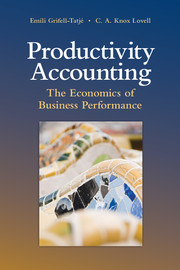Book contents
- Frontmatter
- Dedication
- Contents
- List of Tables
- List of Figures
- Preface
- 1 Introduction
- Part I Productivity and Profitability
- Part II Productivity and Profit
- Part III Productivity, Cost, and Return on Assets
- 7 Productivity and Cost
- 8 Productivity, Capacity Utilization, and Return on Assets
- Bibliography
- Author Index
- Subject Index
7 - Productivity and Cost
Published online by Cambridge University Press: 05 January 2015
- Frontmatter
- Dedication
- Contents
- List of Tables
- List of Figures
- Preface
- 1 Introduction
- Part I Productivity and Profitability
- Part II Productivity and Profit
- Part III Productivity, Cost, and Return on Assets
- 7 Productivity and Cost
- 8 Productivity, Capacity Utilization, and Return on Assets
- Bibliography
- Author Index
- Subject Index
Summary
Introduction
Subsequent to the global economic downturn that began in 2008, firms responded in various ways, but primarily through efforts to match declining revenues with cost reductions. Examples culled from media reporting include, and are not limited to, workforce reductions, rewriting labor contracts to reduce real wages and benefits, increasing reliance on outsourcing and offshoring, undertaking “transformative” changes to the cost structure, adopting cost-saving new technologies, and reducing service quality. Some of these actions are attempts to reduce waste, others are attempts to reduce the levels of efficient costs, and others involve downsizing. Borenstein and Farrell (2000) assign these and more examples to either of two categories: (i) trimming fat, and (ii) re-optimizing in response to changes in exogenous factors.
In Section 6.3.4 of Chapter 6 we introduced the notion that we might wish to measure and decompose productivity change within a cost change framework, ignoring the contribution of revenue change to profit change. In this chapter we follow up on that notion by exploring the relationship between financial performance and productivity performance in an environment that ignores the revenue half of the picture. In such an environment financial performance depends on cost, and productivity performance depends on output and input quantities, and also on input prices. We begin in Section 7.2 with a brief discussion of variance analysis as it is presented in cost accounting textbooks. Variance analysis identifies essentially the same cost drivers as economic analysis does, although from a different perspective and under different assumptions. Indeed, a central tenet of variance analysis is that input-oriented productivity change is a key driver of cost change. This discussion helps motivate subsequent analyses in Sections 7.3 and 7.4, where we use a cost frontier to estimate and decompose the contribution of productivity change to cost change. In Section 7.5 we change the financial performance indicator from cost to unit cost, a widely used performance indicator. In Section 7.6 we focus on partial factor productivities, which we relate to total factor productivity and unit cost. In Section 7.7 we narrow the indicator from unit cost to unit labor cost, another widely used performance indicator, particularly in international comparisons. Throughout the chapter we use a mixture of ratio (Chapters 2 and 3) and difference (Chapters 4 to 6) models to conduct our analyses. Section 7.8 concludes.
- Type
- Chapter
- Information
- Productivity AccountingThe Economics of Business Performance, pp. 277 - 309Publisher: Cambridge University PressPrint publication year: 2015



